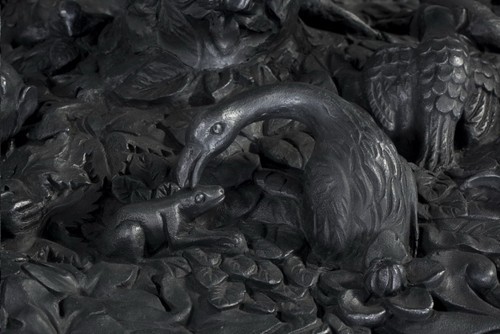Jitish Kallat
15 Feb - 27 Mar 2010
JITISH KALLAT
"The Astronomy of the Subway"
February 15 - March 27, 2010
In February 2010, Haunch of Venison London will present an exhibition of new work by the Indian artist Jitish Kallat. Following his acclaimed exhibition at Haunch of Venison Zurich in 2008, Kallat's new work showcases the full range of his visual vocabulary incorporating video, sculptural installation, photography and the large format paintings for which he is best known. Tackling his foundational themes of sustenance, survival and mortality in the contemporary urban environment of Mumbai, Kallat offsets a vivid, hand-made aesthetic with digitised renderings of streets fit-to-burst, where the cumulative impression of daily existence is pushed to the extreme.
At the heart of the artist's interest in the bustling metropolis lies the experience of the individual within the crowd. This is driven by a play on scale, understood in terms of a subject's physical and metaphorical presence. Across two and three dimensions, using a variety of media, and through assimilating the local with the universal, Kallat checks the twenty-first century's obsession with effects - images, food, products, even people by repositioning them in unfamiliar environments. A large video projection shows x-rayed foodstuffs projected onto a dark celestial space and pouring into view as asteroids, stellar formations, planetary clusters and nebulae. In a sculptural installation, a miniature crowd of rioting figures scatters across the floor, their scale exaggerated by the viewer's height, as if seen through the wrong end of a telescope.
Another piece in the exhibition is an intricately treated sculpture of an oversized black lead kerosene stove that carries more than a hundred images on it. These are culled from the porch of the Victoria Terminus building which is the nerve centre of Mumbai's commuter action. Curiously, the decorative architectural friezes carry several images of animals devouring each other and clinging onto various foods. Viewed together on a single sculpture, this sprawling mass is not unlike the daily grind of survival that this porch bears witness to. In large paintings elsewhere, the body is abstracted into ink blot formations, its stretched muscles and dripping fluids becoming receptacles of urban trauma.
Undermining conventional notions of the local and universal, the micro and the macro, and the way the two infect one another, Jitish Kallat's forthcoming exhibition is a sustained meditation on the urban dwelling condition where the struggle between self-improvement and social disorder is at its most stark. The corpus of evidence Kallat presents is bound by Tristan Tzara's Dada poem, 'The Great Lament Of My Obscurity Three', which he re-presents here as a text made from bone. Its combination of the close at hand, the nonsensical and the cosmic -'let us always shuffle through the colour of the world/which looks bluer than the subway and astronomy... our legs are stiff and knock together - distils the world, half-here and half-there, mine yet theirs, which Kallat repeatedly evokes.
"The Astronomy of the Subway"
February 15 - March 27, 2010
In February 2010, Haunch of Venison London will present an exhibition of new work by the Indian artist Jitish Kallat. Following his acclaimed exhibition at Haunch of Venison Zurich in 2008, Kallat's new work showcases the full range of his visual vocabulary incorporating video, sculptural installation, photography and the large format paintings for which he is best known. Tackling his foundational themes of sustenance, survival and mortality in the contemporary urban environment of Mumbai, Kallat offsets a vivid, hand-made aesthetic with digitised renderings of streets fit-to-burst, where the cumulative impression of daily existence is pushed to the extreme.
At the heart of the artist's interest in the bustling metropolis lies the experience of the individual within the crowd. This is driven by a play on scale, understood in terms of a subject's physical and metaphorical presence. Across two and three dimensions, using a variety of media, and through assimilating the local with the universal, Kallat checks the twenty-first century's obsession with effects - images, food, products, even people by repositioning them in unfamiliar environments. A large video projection shows x-rayed foodstuffs projected onto a dark celestial space and pouring into view as asteroids, stellar formations, planetary clusters and nebulae. In a sculptural installation, a miniature crowd of rioting figures scatters across the floor, their scale exaggerated by the viewer's height, as if seen through the wrong end of a telescope.
Another piece in the exhibition is an intricately treated sculpture of an oversized black lead kerosene stove that carries more than a hundred images on it. These are culled from the porch of the Victoria Terminus building which is the nerve centre of Mumbai's commuter action. Curiously, the decorative architectural friezes carry several images of animals devouring each other and clinging onto various foods. Viewed together on a single sculpture, this sprawling mass is not unlike the daily grind of survival that this porch bears witness to. In large paintings elsewhere, the body is abstracted into ink blot formations, its stretched muscles and dripping fluids becoming receptacles of urban trauma.
Undermining conventional notions of the local and universal, the micro and the macro, and the way the two infect one another, Jitish Kallat's forthcoming exhibition is a sustained meditation on the urban dwelling condition where the struggle between self-improvement and social disorder is at its most stark. The corpus of evidence Kallat presents is bound by Tristan Tzara's Dada poem, 'The Great Lament Of My Obscurity Three', which he re-presents here as a text made from bone. Its combination of the close at hand, the nonsensical and the cosmic -'let us always shuffle through the colour of the world/which looks bluer than the subway and astronomy... our legs are stiff and knock together - distils the world, half-here and half-there, mine yet theirs, which Kallat repeatedly evokes.

